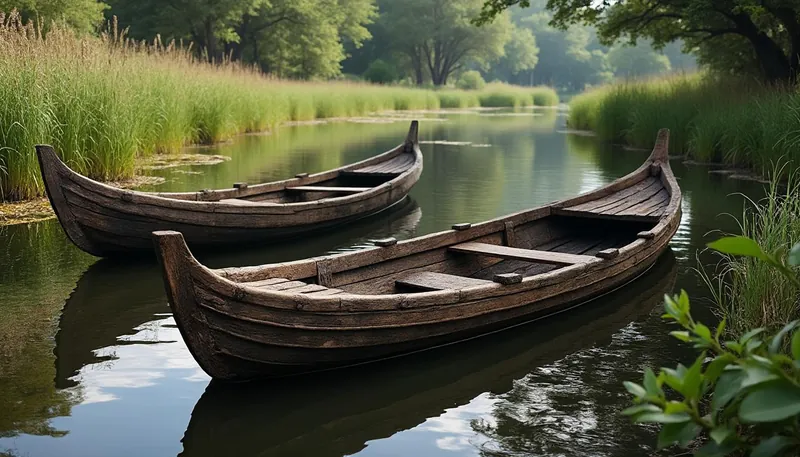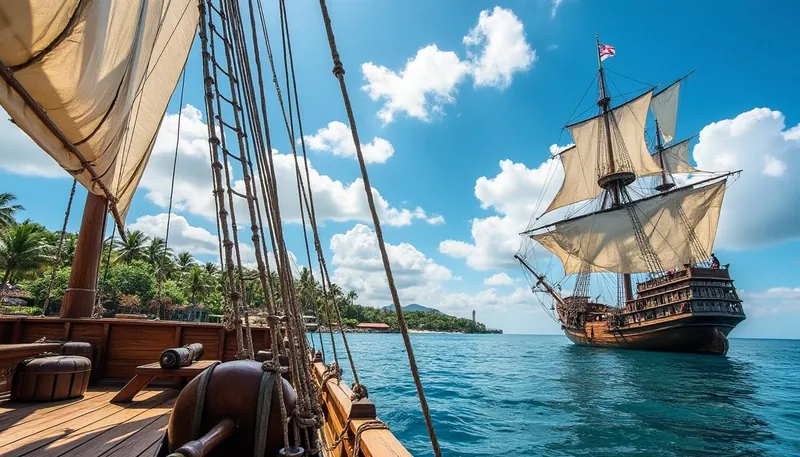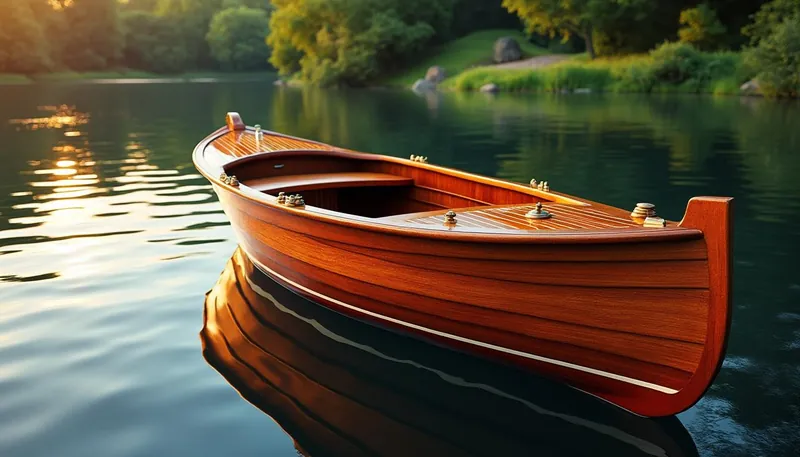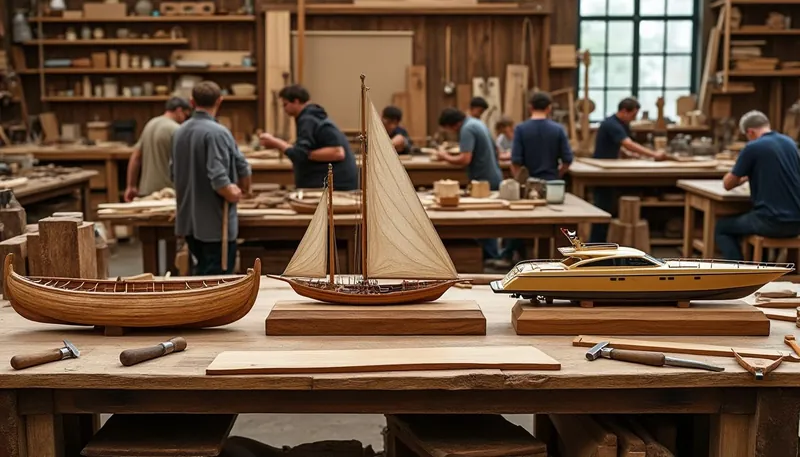Wooden boats have sailed through the annals of human history for millennia, marking significant transformations in trade, exploration, and cultural exchange. From the sedate waters of ancient rivers to the turbulent high seas, these vessels symbolize the innate human spirit of adventure and ingenuity. From simple log rafts to artfully crafted yachts, wooden boats have provided essential links between communities and nations while fostering a deeper understanding of our environment and ourselves. The allure of wooden craftsmanship continues to captivate water enthusiasts, seafarers, and historians alike today. So, how did we arrive at this extensive maritime legacy?
Brief
- Wooden boats have been around for thousands of years, dating back to ancient civilizations.
- Key cultures, like the Egyptians, Greeks, and Romans, contributed to wooden boat evolution.
- The Age of Exploration marked a pivotal shift towards utilizing wooden ships for global navigation.
- Wooden craftsmanship faced challenges with advances in materials, yet has seen a recent revival.
- Modern wooden boats combine traditional techniques with contemporary designs for sustainability.
The Early History of Wooden Boats
The origins of wooden boat construction can be traced back to some of the earliest human civilizations. Evidence suggests that as far back as 4000 BC, the ancient Egyptians were using wooden vessels along the Nile River. Initially, these boats were rudimentary, often made with reeds and papyrus, demonstrating how creativity evolved even in simple forms of transport.
One remarkable aspect of these early boats was their ability to facilitate trade and communication among communities. The use of such vessels proved vital for transporting people and goods, paving the way for commerce alongside waterways. The principles behind boat construction, such as weight distribution and buoyancy, began to emerge during these early periods. Ancient civilizations, including Mesopotamia and the Indus Valley, each developed their distinct types of wooden boats, often tailored to their unique geographical and cultural environments.
As societies advanced, the craft of boat-building saw innovation in both design and materials. The earliest boats served essential purposes; nonetheless, the transition towards utilizing more robust materials became inevitable as civilizations aspired for greater durability and performance. From simple log rafts to more sophisticated hull designs, the journey of wooden boats mirrored the civilizations that built them.
| Era | Notable Boat Types | Culture | Purpose |
|---|---|---|---|
| 4000 BC | Reed Boats | Ancient Egyptians | Transport, trade |
| 3200 BC | Log Boats | Mesopotamia | Fishing, trade |
| 1000 BC | Wooden Galleys | Ancient Greeks | Naval warfare, exploration |

Lessons from the Ancients
Each ancient culture contributed unique techniques and styles to the art of boat building. From the Egyptians’ use of wood and reeds to the elaborate wooden ships of the ancient Greeks, boat designs grew more complex as a response to the needs of warfare and trade. The Greeks, known for their naval innovations, introduced critical advancements like the trireme, a warship featuring multiple rows of oars. This design’s efficiency was a game-changer, as it allowed for greater speed and maneuverability on the water. While the ancient Romans built upon these innovations for both commerce and conquest, engaging with cultures across the Mediterranean, they also optimized hull shapes for better stability and capacity.
Learning from the past can give modern boat builders insight into sustainable practices rooted in respect for resources and the environment. For instance, traditional boat building often involved selecting local woods like oak or cedar, fostering a relationship that served both the craft and the community. The craftsmanship displayed in ancient boat designs continues to influence contemporary builders, ensuring that the stories of our early mariners live on.
The Age of Exploration: Wooden Ships at the Forefront
The 15th and 16th centuries marked the Age of Exploration, where adventurers like Christopher Columbus and Ferdinand Magellan set sail on wooden ships that changed the course of history. During this dynamic time, wooden vessels such as caravels gained prominence. These ships were ideal for exploration, featuring a nimble design, often equipped with triangular sails which improved handling and speed in varying wind conditions.
This influence of wooden boat technology meant that empires expanded, trade routes established, and cultures connected. Wooden ships served as the backbone of this era, symbolizing adventure and discovery. The designs improved as shipbuilders recognized the importance of stability, cargo capacity, and sailing performance. These innovations enhanced ships’ ability to endure long voyages across uncharted territories, paving the way for international trade and cultural exchanges that resonate today.
- Caravels: Agile ships with triangular sails.
- Galleons: Large, multi-decked ships known for cargo transport.
- Fluyts: Dutch-built designs emphasizing capacity and cost-effectiveness.
Maritime Maneuvers and the Technology of Wooden Ships
New naval technologies emerged alongside expanding maritime empires. Innovations in cartography helped sailors navigate accurately and effectively, and weapons technology advanced, leading to the incorporation of cannons aboard wooden ships. These protected vessels, allowing sailors to defend against piracy and rival nation-states. The ligneous craft proved invaluable for military engagements and establishing dominion over oceans.
After the Renaissance, wooden boats underwent a series of significant renovations, elevating aesthetics while serving their original purposes. Details such as intricate figureheads and ornately carved hulls reflected craftsmanship, blending function and art. On the other hand, these beautiful designs didn’t just appeal to the rich; they represented the aspirations of communities rallying around a common cause—maritime dominance.
| Ship Type | Features | Notable Essence |
|---|---|---|
| Caravel | Triangular sails, lightweight | Exploration and trade |
| Galleon | Multi-deck, heavily armed | Colonial power projection |
| Fluyt | Shallow draft, cargo-centric | Efficient trade routes |

The Golden Age of Wooden Ships: Craftsmanship and Competition
The 17th and 18th centuries ushered in the Golden Age of Wooden Ships, where nations like England, France, and Spain raced to create formidable warships. Craftsmanship during this period reached unparalleled heights, where towering vessels like the HMS Victory showcased the pinnacle of naval engineering. Launched in 1765, this iconic ship represented the British naval power, testament to the elaborate shipbuilding skills of the time.
Designs incorporated high decks, advanced rigging systems, and better hulls to withstand harsh ocean conditions. The competition for supremacy encouraged innovation and creativity in boat construction, leading to impressive feats of design; ships were not merely tools but symbols of national pride. In these naval rivalries, woodworkers continuously refined their techniques and artistic expression in wooden boats, transforming them into intricately built masterpieces.
- Larger ships allowed for more cannons, enhancing combat effectiveness.
- Cultural influences led to variations in ship designs across nations.
- Shipbuilding guilds emerged, bolstering local craftsmanship and techniques.
The Shift in Maritime Focus
As naval warfare became more sophisticated, wooden ships faced new challenges as steam engines and iron hulls began to rise in popularity. The 19th century saw a major technological shift towards steam-powered vessels, which drastically altered maritime expectations. However, wooden ships still found their place within this dynamic framework. The introduction of wooden steamboats combined the aesthetic appeal of wood with the advancements of steam propulsion.
Steamships opened new trade routes and opportunities. Although the world of wooden boats changed dramatically, the spirit of wooden craftsmanship remained alive, preserving techniques and cultural practices intertwined with these vessels.
The Modern Era: A Resurgence of Wooden Boat Craftsmanship
Factors influencing this revival encompass: Modern wooden boat builders embrace both traditional techniques and contemporary methods to create exquisite vessels. For instance, wood-epoxy construction and cold-molded methods have gained popularity, blending timeless designs with innovative technological approaches. These methods enhance customizability, allowing builders to tailor every vessel to the owner’s specifications. Moreover, utilizing composite materials enables even further design flexibility while maintaining the aesthetic appeal characteristic of wooden boats. Today’s custom wood boats serve not only as leisure vehicles but also honor the traditions and stories of yesteryear, proving that wooden craftsmanship transcends time. Communities continue to celebrate classic boats, stimulating interest in maritime heritage and inspiring the next generation of boat builders and enthusiasts.
Resurgence Factor
Description
Implications
Heritage Preservation
Emphasis on traditional craftsmanship
Enduring appreciation for artisanship
Sustainability
Focus on renewable resources
Lower environmental impact
Artistry
Unique, customized designs
Personal expression in boating
Innovative Techniques in Boat Building


